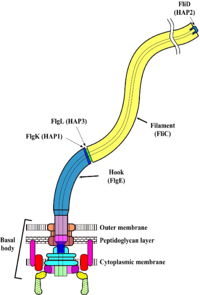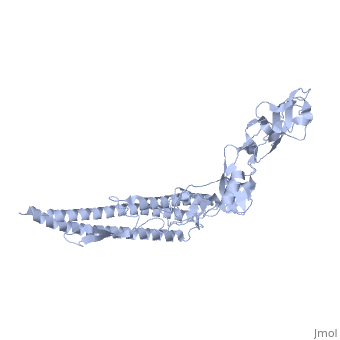
The bacterial flagellum consists of a filament, a universal joint (hook), and a motor (basal body).
Flagella (singular: flagellum) enable bacteria to swim towards sources of nutrition, and away from sources of toxins. Such directed motility is termed chemotaxis. Rapid swimming helps Bdellovibrio penetrate and parasitize their host bacteria, but flagella are not always essential for virulence[1]. Flagella are important in responses to quorum sensing[2] and biofilm formation[3][4]. Flagella may also be involved in functions other than motility[5].
For further information, please see Flagellum at Wikipedia.
The bacterial flagellum is made up of about 25 different proteins. There are only a few copies of some proteins, and tens of thousands of copies of the filament protein, FliC. The flagellum is made up of three major regions, as follows.
Motor
At the base of a bacterial flagellum is a reversible motor, also called the basal body. The source of energy driving the motor is an electromotive gradient of, in some bacteria, protons (hydrogen ions, H+) or, in other bacteria, sodium ions (Na+). The gradient has a higher concentration of ions outside the cell, and a lower concentration of ions inside the cell. Ions flow from outside to inside the bacterial cell, passing through the motor and driving its rotation by a mechanism which is poorly understood.
For more details see Flagellar biosynthetic protein
Filament (Propeller)
The flagellar filament is a relatively rigid, helical rod, typically many times the length of the bacterial cell. Many motile bacteria, including Salmonella, have multiple flagella extending from each cell. Rotation of the filaments by the motor is what propels the cell. More...
For more details see Flagellar proteins
Hook (Universal Joint)
The filament is attached to the motor with the flagellar hook, which is a molecular universal joint. The hook is flexible, allowing the angle between the filament and the bacterial cell surface to change over a wide range. However, the hook efficiently transmits torque from the motor to the filament, causing it to rotate.
For details see
Assembly
During assembly of the flagellum, its protein components are transported through hollow cores of the basal body, hook and filament, assembling at the end of the nascent flagellum[6]. The Namba Group has prepared a movie illustrating their understanding of the assembly process as of about 2004.
3D structures of flagellar protein
Updated on 27-May-2018
Lists of Flagellar Structures
These are automatically-generated lists of PDB codes.
and there are undoubtedly other flagellum-related Categories ...
See Also
Within Proteopedia:
External Links


